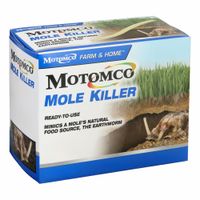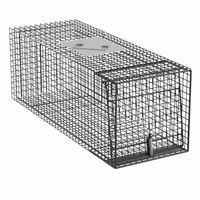Call +(254) 703 030 000 / 751 483 999 / 721 704 777
- Home
- Outdoor Equipment
- Insect Wildlife Control
- Wildlife Control
.....Read More
Frequently Asked Questions
What are the most effective wildlife control products for repelling pest animals?
The most effective wildlife control products for repelling pest animals include:
1. **Ultrasonic Repellents**: These devices emit high-frequency sounds that are unpleasant to animals like rodents, raccoons, and deer but are inaudible to humans. They are effective for indoor and outdoor use, covering large areas.
2. **Motion-Activated Sprinklers**: These devices detect movement and release a burst of water, startling animals such as deer, raccoons, and birds. They are eco-friendly and can cover a wide area, making them ideal for gardens and lawns.
3. **Chemical Repellents**: Available in granules, sprays, or liquid forms, these products use natural or synthetic ingredients to deter animals. For example, capsaicin-based repellents are effective against mammals, while garlic or peppermint oil can repel insects and rodents.
4. **Physical Barriers**: Fences, netting, and spikes can prevent animals from accessing certain areas. Electric fences are particularly effective for larger animals like deer and wild boars, while bird spikes and netting can protect structures from birds.
5. **Visual Deterrents**: Reflective tapes, scarecrows, and predator decoys can scare away birds and small mammals. These are most effective when combined with other methods to prevent animals from becoming accustomed to them.
6. **Scent Repellents**: These products use predator urine or other strong scents to create an environment that feels unsafe for pest animals. They are effective for deer, rabbits, and other mammals.
7. **Traps**: While not repellents, humane traps can capture and relocate animals. They are effective for controlling populations of rodents, raccoons, and other small mammals.
Combining multiple methods often yields the best results, as animals can become accustomed to a single type of deterrent. Regularly changing and maintaining these products enhances their effectiveness.
How do wildlife repellents work to keep animals away from protected areas?
Wildlife repellents work by exploiting the sensory perceptions of animals, such as smell, taste, and sound, to deter them from entering protected areas. These repellents can be categorized into several types based on their mode of action:
1. **Olfactory Repellents**: These use strong or unpleasant odors to deter animals. For example, predator urine or synthetic chemicals mimic the scent of predators, triggering a fear response in prey animals. Other olfactory repellents may include substances like garlic or rotten eggs, which are offensive to the animal's sense of smell.
2. **Taste Repellents**: These are applied to plants or surfaces to make them taste bad to animals. Ingredients like bittering agents or hot pepper extracts cause discomfort when ingested, discouraging animals from feeding on treated areas.
3. **Auditory Repellents**: These devices emit sounds that are distressing or alarming to animals. Ultrasonic devices produce high-frequency sounds inaudible to humans but disturbing to certain wildlife. Other auditory repellents may mimic predator calls or use sudden loud noises to scare animals away.
4. **Visual Repellents**: These include objects or lights that create visual disturbances. Reflective tapes, flashing lights, or scarecrows can confuse or frighten animals, making them avoid the area.
5. **Tactile Repellents**: These create an uncomfortable physical sensation. Sticky or slippery substances can be applied to surfaces to deter animals from climbing or walking on them.
Repellents are often used in combination to increase effectiveness, as animals can become habituated to a single type of deterrent over time. The choice of repellent depends on the target species, the environment, and the specific area being protected. Regular reapplication and variation in repellent types can help maintain their efficacy.
What types of traps are best for capturing and removing live animals?
The best traps for capturing and removing live animals are typically humane traps designed to minimize stress and injury to the animal. These traps vary depending on the species being targeted:
1. **Cage Traps**: These are versatile and commonly used for small to medium-sized animals like raccoons, squirrels, and feral cats. They are made of wire mesh and have a door that closes when the animal steps on a trigger plate. They allow for easy monitoring and safe release.
2. **Box Traps**: Similar to cage traps but often made of solid materials like wood or plastic. They are used for animals like rabbits and small rodents. The solid sides can reduce stress by limiting the animal's view of the outside.
3. **Tube Traps**: These are effective for capturing small mammals such as mink or weasels. The cylindrical shape can be more inviting for certain species and can be placed in narrow spaces.
4. **Drop Traps**: Used for birds and some small mammals, these traps involve a net or cage that drops over the animal. They require careful monitoring to ensure the animal is not trapped for too long.
5. **Snare Traps**: When used with a stop to prevent full closure, snares can be humane for capturing animals like foxes or coyotes. They should be checked frequently to prevent injury.
6. **Pitfall Traps**: Often used for reptiles and amphibians, these involve a container buried in the ground. They must be checked regularly to prevent harm from exposure or predators.
7. **Specialized Traps**: For specific species, such as bats or birds, specialized traps like mist nets or harp traps are used. These require expertise to ensure humane capture and handling.
In all cases, it is crucial to follow local wildlife regulations and guidelines to ensure ethical and legal trapping practices.
Are there humane options for wildlife control and removal?
Yes, there are humane options for wildlife control and removal that prioritize the well-being of animals while addressing human-wildlife conflicts. These methods focus on prevention, exclusion, and non-lethal deterrence.
1. **Habitat Modification**: Altering the environment to make it less attractive to wildlife can prevent conflicts. This includes securing garbage, removing food sources, and sealing entry points to buildings.
2. **Exclusion Techniques**: Physical barriers such as fences, netting, and chimney caps can prevent animals from entering areas where they are not wanted. These methods are effective for keeping out larger animals like deer and raccoons.
3. **Repellents**: Natural and chemical repellents can deter wildlife from specific areas. These include predator urine, noise devices, and taste aversive substances. They should be used according to guidelines to ensure they are safe for both animals and humans.
4. **Trapping and Relocation**: When necessary, humane traps can be used to capture and relocate animals. This should be done by professionals to ensure the safety and legal compliance of the process. Relocation should be a last resort, as it can be stressful for animals and may not always be legal or effective.
5. **Behavioral Modification**: Techniques such as hazing or aversive conditioning can teach animals to avoid certain areas. This involves using non-harmful stimuli to create negative associations with specific locations.
6. **Community Education**: Educating the public about coexisting with wildlife and implementing community-based management plans can reduce conflicts. This includes understanding animal behavior and promoting tolerance and coexistence.
These humane methods aim to balance the needs of humans and wildlife, ensuring ethical treatment while effectively managing wildlife populations.
How can mole killers be used to reduce subterranean mole populations?
Mole killers, often in the form of baits or traps, are effective tools for reducing subterranean mole populations. These products are designed to target moles directly within their tunnels, where they are most active.
Baits typically contain toxic substances that mimic the moles' natural food sources, such as earthworms or grubs. To use them effectively, locate active mole tunnels by flattening a small section and checking for repairs after 24-48 hours. Once an active tunnel is identified, place the bait directly into the tunnel, ensuring it is covered to prevent non-target animals from accessing it. The mole ingests the bait while foraging, leading to its demise.
Traps, on the other hand, physically capture or kill moles. There are several types, including scissor traps, harpoon traps, and choker loop traps. To set a trap, identify an active tunnel as described above. Carefully excavate a small section of the tunnel and place the trap according to the manufacturer's instructions, ensuring it is securely positioned. Cover the trap with soil or a board to block light and prevent disturbance. Regularly check the traps and reset them as needed until mole activity ceases.
Both methods require patience and persistence, as moles are solitary creatures with extensive tunnel networks. It's crucial to follow all safety guidelines and local regulations when using mole killers to minimize risks to humans, pets, and non-target wildlife. Additionally, integrating these methods with habitat modification, such as reducing soil moisture and removing food sources, can enhance long-term control of mole populations.
What are the safety considerations when using wildlife control products?
When using wildlife control products, safety considerations are crucial to protect humans, non-target animals, and the environment. First, always read and follow the manufacturer's instructions and labels to ensure proper use and application. Personal protective equipment (PPE) such as gloves, masks, and goggles should be worn to prevent direct contact with potentially harmful substances.
Consider the impact on non-target species. Many wildlife control products can affect pets, livestock, and beneficial wildlife. Use targeted methods and products that minimize risks to these animals. For instance, select traps or deterrents that are species-specific.
Environmental safety is another key consideration. Avoid using products near water sources to prevent contamination. Be mindful of weather conditions; rain can cause chemicals to spread, while wind can carry them to unintended areas.
Storage and disposal of wildlife control products must be handled with care. Store them in a secure, dry place away from children and animals. Follow local regulations for disposal to prevent environmental harm.
If using chemical repellents or poisons, be aware of potential human health risks. Ensure that these products are kept out of reach of children and that areas treated with chemicals are clearly marked to prevent accidental exposure.
Finally, consider the ethical implications and legal regulations surrounding wildlife control. Some methods may be restricted or require permits. Always opt for humane and legal solutions, and consult with wildlife professionals if unsure.
By adhering to these safety considerations, you can effectively manage wildlife issues while minimizing risks to health, non-target species, and the environment.
How do I choose the right wildlife control product for my specific pest problem?
To choose the right wildlife control product for your specific pest problem, follow these steps:
1. **Identify the Pest**: Determine the type of wildlife causing the issue. Common pests include rodents, birds, raccoons, and insects. Accurate identification is crucial for selecting an effective control method.
2. **Assess the Severity**: Evaluate the extent of the infestation. A minor issue might require a different approach than a severe infestation.
3. **Research Control Methods**: Understand the available control options, such as traps, repellents, exclusion devices, and poisons. Each method has specific applications and effectiveness depending on the pest.
4. **Consider Safety**: Prioritize products that are safe for humans, pets, and the environment. Non-toxic and humane options are preferable, especially in residential areas.
5. **Check Regulations**: Ensure compliance with local wildlife control laws and regulations. Some species may be protected, and certain control methods might be restricted.
6. **Evaluate Product Effectiveness**: Look for products with proven efficacy. Read reviews, seek recommendations, and consult pest control professionals if necessary.
7. **Consider Long-term Solutions**: Opt for products that offer sustainable and long-term control rather than temporary fixes. Exclusion and habitat modification can prevent future infestations.
8. **Budget**: Balance cost with effectiveness. While some products may be more expensive, they might offer better results and long-term savings.
9. **Ease of Use**: Choose products that are easy to install and maintain. Complex systems may require professional assistance.
10. **Manufacturer Support**: Select products from reputable manufacturers that offer customer support and warranties.
By carefully considering these factors, you can select the most appropriate wildlife control product for your specific pest problem, ensuring effective and humane management.


